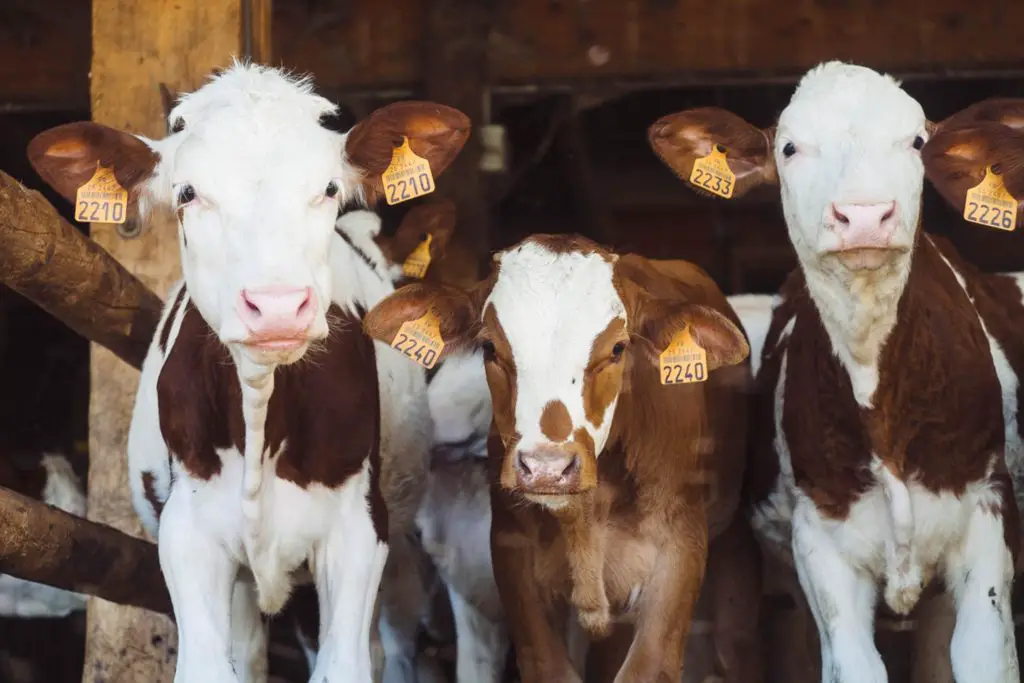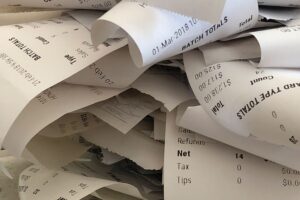5 Key Environmental Impacts of Meat, Seafood and Dairy Consumption

This has nothing to do with organisation. It’s more to do with the actions I am taking to lead a more eco-friendly and sustainable life. I’m pretty sure all future posts will be along these lines as this is my online journal.
The facts and figures shift and change over time but one thing is clear – the environmental impact of meat and dairy production is significantly higher than crop and vegetable production and our planet can not sustain our current consumption levels. That’s the conclusion I have come to.
In this post I have summarised the five impacts meat, dairy and seafood production has had on our planet and the facts that I have gathered in relation to these issues.
At the moment I have referenced a small handful of sources. These references are noted by the figure in brackets (). These facts and figures are from sources that are referencing the work of others. Where I know of those other sources I have referenced them by the number in the square brackets [ ].
Clearly, I am no researcher. I’m just a mum trying to use the little downtime I have to learn what I can from sources that are easily accessible to me. I hope to update this over time and do a better job. We will see. But for now here it is:
1. Climate change
- According to the Australian Government Department of Agriculture, Water and the Environment, livestock emissions account for roughly 10% of Australia’s greenhouse gases (1)
- As a byproduct of their four-stomached digestive system, cattle produce and emit significant quantities of methane – a greenhouse gas that is 23 times more potent by quantity than CO2 [1][2] Given this methane production, livestock-related deforestation, and other greenhouse gas-heavy practices, the livestock industry is thought to be responsible for18% of all man made greenhouse gas emissions [3](2).
- Livestock contributes 14.5% of total global emissions with 39% of that attributable to methane. (3)
- Methane makes up 16% of total greenhouse gas emissions with methane from livestock making up around 44% of that figure. (3)
- Some estimates say as much as 40% of historic global warming is caused by forest clearance that was undertaken to make way for animal agriculture. [60] (1)
- Land clearing and deforestation for agriculture makes up 15-18% of our food systems greenhouse gas emissions with the vast majority (70-90%) of all land cleaning being for sugar cane, soy and maize (mostly grown to feed livestock). Clearing of the land plus constant ploughing or tilling of the soil has released 155 tonnes of carbon into the atmosphere. (3)
- Red meat is responsible for 10 to 40 times as many greenhouse gas emissions as veggies and grains [41] (1)
- Beef create up to 105kg of greenhouse gases per 100g of meat, compared to tofu which produces less than 3.5 kg [42] (1)
- A global switch to more veggie-focused diets could reduce greenhouse gas emissions by two thrids and save 8 million lives by 2050 [40] (1)
2. Water usage
- Meat accounts for 22% of all water use [47] (1)
- To produce 1kg beef requires over 13,000 L of water; a water footprint 6 times larger than for pulses. [46] (1)
- Estimates indicate that the production of 1kg of beef requires about 43,000L of fresh water, including both raising the livestock itself and growing the crops needed to feed it. For comparison, 1kg of grain only requires 1,000L.[13] In terms of calories, that’s 20 times greater water footprint for beef as compared to cereals, and a 6 times greater water footprint for beef as compared to its protein-equivalent in pulses (such as beans, peas, and lentils). (2)
- A plant-based diet will reduce the amount of water we need to produce our food by 25% 60 (1)
- It takes about 1,000 litres of water to make 1 L of dairy milk compared to 297 L for the same amount of soy milk. [43] (1)
3. Land use and deforestation
- About 55% of the world land is farmed and 80-85% of this is used to raise animals 60 (1)
- Livestock covers 45% of the earth’s total land.[4] (1)
- It is estimated that 26% of the entire Earths surface is now used for livestock grazing [9] (1)
- According to the Food and Agriculture Organisation of the United Nations (FAO), roughly 26% of the earth’s land surface is used for farming livestock, while 33% of croplands are used for livestock feed production. (1)
- One-third of the world’s cropland is used to grow food for animals (3)
- 70-80% of Amazon deforestation is for cattle ranching (3)
- 80% of the soy that is grown in the Amazon is fed to animals [63] (1)
- If as much of the land currently set aside for grazing animals is regrown as trees, it will help remove carbon from the atmosphere – it is estimated there could be a reduction in greenhouse gases by as much as 30 – 50%. [60] (1)
4. Species extinction
- Half of all marine life has been lost in the last 40 years [54] (1)
- 87% of fish populations are full or overexploited [52] (1)
- We have killed 90% of big ocean predatory fish [53] (1)
- As populations have decreased, making fishing more difficult, the fishing industry has turned to more intensive practices, such as trawling, to make up the difference. But as nets are trawled, or dragged along the ocean floor, they cause significant damage to the natural habitat, affecting coral reefs in particular. Coral reefs, vital in maintaining fish populations and oceanic biodiversity, face considerable, long-term damage from this method of fishing.[23][24][25][26](2)
- Another effect of most fishing methods, including trawling, is bycatch – a term for marine life (and often birds) that are accidentally caught as a byproduct of fishing practices. Bycatch affects and threatens the population of many species, including sea turtles and sea mammals such as dolphins, porpoises, and seals.[27][28][29][30][31] (2)
- Aquaculture is also associated with the destruction of valuable wetland habitats, such as salt marshes and mangrove forests.[35] (2)
- Currently, 25,000 species are threatened with extinction because of agriculture. Freeing up the land given over to animal farming will take some of this pressure from the global biodiversity crisis. 60 (1)
5. Waste and inefficiencies
- Animal farming uses up 83% of global agricultural land but provides just 18% of global calories [38] (1)
- Cows convert only 4% of the proteins and 3% of the calories of the plants we feed them into beef [45] (1) so 97% of the calories they consume is completely lost to us.
- Fishing is inefficient – for every 1lb of fish caught, up to 5lb of unintended marine species are caught and discarded as by-kill [56] (1)
- 82% of the world starving children live in countries where food is feed to animals, which are then killed for meat and exported; eaten by wealthier individuals in developed countries like the US, UK and mainland Europe. [37] (1)
- Only 6% of the soy produced globally is consumed by humans [65] (1)
- If all grain were fed to humans, we could feed an extra 3.5 million people [59] (1)
- In addition, more than a billion extra tons of food crops could go to humans if we stopped feeding them to animals 60(1)
It’s not all clear cut, the figures can vary widely depending on how you look at things and the time period being considered. But overall its doesn’t sound too good, the direction we are heading.
References
(1) Bosh: How to live vegan, Henry Firth & Ian Theasby (2019)
[4] Carrington, D. (2017) Earths sixth mass extinction event under way scientists warn, https://www.theguardian.com/environment/2017/jul/10/earths-sixth-mass-extinction-event-already-underway-scientists-warn
[9] Bland, A. (2012), Is the livestock industry destroying the planet?, https://www.smithsonianmag.com/travel/is-the-livestock-industry-destroying-the-planet-11308007/
[14] Haiang, S.M., Burke, M. and Miguel, E. (2013), Quantifying the influence of climate change on human conflict, https://science.sciencemag.org/content/341/6151/1235367
[37] Oppenlander, R. (2013), Animal agriculture, Thunder and how to feed a growing population, https://www.forksoverknives.com/wellness/animal-agriculture-hunger-and-how-to-feed-a-growing-global-population-part-two-of-two/
[38] Million Dollar Vegan, World Hunger, https://www.milliondollarvegan.com/category/world-hunger/
[40] University of Oxford (2016), Veggie based diets could save 8 million lives by 2050 and cut global warming, https://www.ox.ac.uk/news/2016-03-22-veggie-based-diets-could-save-8-million-lives-2050-and-cut-global-warming
[41] Scientific American, How does meat in the diet take an environmental toll? https://www.scientificamerican.com/article/meat-and-environment/
[42] Poore, J. and Nemeck, T (2018) Reducing food environmental impacts through producers and consumers, https://science.sciencemag.org/content/360/6392/987
[43] Whyte, C. (2018) Milk alternatives: which are good for both you and the planet. https://www.newscientist.com/article/mg23931963-500-milk-alternatives-which-are-good-for-both-you-and-the-planet/
[45] Sheppn, A., Eshel, G., Noor, E. and Milo, R. (2016), Energy and protein feed to food conversion efficiencies in the US and potential food security gains from dietary changes, https://iopscience.iop.org/article/10.1088/1748-9326/11/10/105002/meta
[46] Mekonnen, M.M. and Howkstra, A.y. (2010), The green, blue and grey water footprint of farm animals and animal products, https://www.researchgate.net/publication/254859487_The_green_blue_and_grey_water_footprint_of_farm_animals_and_animal_products
[47] Hoekstra, A.Y. and Mekonnen, M.M. (2012), The water footprint of humanity, https://pubmed.ncbi.nlm.nih.gov/22331890/
[52] Fujita, R. (2012), FAO reports 87% of the worlds fisheries are overexploited or fully exploited, http://blogs.edf.org/edfish/2012/07/11/fao-reports-87-of-the-worlds-fisheries-are-overexploited-or-fully-exploited/
[53] Myers, R.A. and Worm, B. (2005) Extiction, survival or recovery of large predatory fishes, https://www.ncbi.nlm.nih.gov/pmc/articles/PMC1636106/
[54] CBS News (2006), Saltwater fish extinction seen by 2048, https://www.cbsnews.com/news/salt-water-fish-extinction-seen-by-2048/
[56] Food and Agriculture Organisation of the United Nations, Discards and bycatch in shrimp trawl fisheries, http://www.fao.org/3/w6602e/w6602E09.htm
[59] The conversation (2017), Five ways the meat on your plate is killing the plant, https://theconversation.com/five-ways-the-meat-on-your-plate-is-killing-the-planet-76128
[60] The impact of meat and dairy on the planet, Dr Joseph Poore, https://www.youtube.com/watch?v=WJ25O_BD5OM
[63] Global Forest Atlas, Soy Agriculture in the Amazon basin, https://globalforestatlas.yale.edu/amazon/land-use/
[65] Good, K., Explain like I’m 5: Why tofu consumption is not responsible for soy related deforestation, https://www.onegreenplanet.org/environment/why-tofu-consumption-is-not-responsible-for-soy-related-deforestation/
[1] Shih, J.-S., Burtraw, D., Palmer, K., & Siikamäki, J. (2008). Air Emissions of Ammonia and Methane from Livestock Operations: Valuation and Policy Options. Journal of the Air & Waste Management Association, 58(9), 1117–1129. doi:10.3155/1047-3289.58.9.1117
[2] Charmley, E., Stephens, M. L., & Kennedy, P. M. (2008). Predicting livestock productivity and methane emissions in northern Australia: development of a bio-economic modelling approach. Australian Journal of Experimental Agriculture, 48(2), 109–113.
[3] FAO Livestock Environment and Development. (n.d.). The Role of Livestock in Climate Change. Retrieved from http://www.fao.org/agriculture/lead/themes0/climate/en/
[4] McMichael, A. J., Powles, J. W., Butler, C. D., & Uauy, R. (2007). Food, livestock production, energy, climate change, and health. The Lancet, 370(9594), 1253–1263. doi:10.1016/S0140-6736(07)61256-2
[5] Steinfeld, H., Gerber, P., Wassenaar, T., Castel, V., Rosales, M., & De Haan, C. (2006). Livestock’s long shadow. FAO Rome. Retrieved from http://www.globalmethane.org/expo-docs/china07/postexpo/ag_gerber.pdf
[13] Pimentel, D., Berger, B., Filiberto, D., Newton, M., Wolfe, B., Karabinakis, E., … Nandagopal, S. (2004). Water Resources: Agricultural and Environmental Issues. BioScience, 54(10), 909–918. doi:10.1641/0006-3568(2004)054[0909:WRAAEI]2.0.CO;2
[14] Mekonnen, M. M., & Hoekstra, A. Y. (2012). A Global Assessment of the Water Footprint of Farm Animal Products. Ecosystems, 15(3), 401–415. doi:10.1007/s10021-011-9517-8
[23] Althaus, F., Williams, A., Schlacher, T. A., Kloser, R. J., Green, M. A., Barker, B. A., … Schlacher-Hoenlinger, M. A. (2009). Impacts of bottom trawling on deep-coral ecosystems of seamounts are long-lasting. Marine Ecology Progress Series, 397(279-294), 40.
[24] Hall–Spencer, J., Allain, V., & Foss\a a, J. H. (2002). Trawling damage to Northeast Atlantic ancient coral reefs. Proceedings of the Royal Society of London B: Biological Sciences, 269(1490), 507–511.
[25] Thrush, S. F., & Dayton, P. K. (2002). Disturbance to Marine Benthic Habitats by Trawling and Dredging: Implications for Marine Biodiversity. Annual Review of Ecology and Systematics, 33, 449–473.
[26] White, A. T., Vogt, H. P., & Arin, T. (2000). Philippine Coral Reefs Under Threat: The Economic Losses Caused by Reef Destruction. Marine Pollution Bulletin, 40(7), 598–605. doi:10.1016/S0025-326X(00)00022-9
[27] Chuenpagdee, R., Morgan, L. E., Maxwell, S. M., Norse, E. A., & Pauly, D. (2003). Shifting gears: assessing collateral impacts of fishing methods in US waters. Frontiers in Ecology and the Environment, 1(10), 517–524. doi:10.1890/1540-9295(2003)001[0517:SGACIO]2.0.CO;2
[28] Lewison, R. L., Crowder, L. B., Read, A. J., & Freeman, S. A. (2004). Understanding impacts of fisheries bycatch on marine megafauna. Trends in Ecology & Evolution, 19(11), 598–604. doi:10.1016/j.tree.2004.09.004
[29] Read, A. J., Drinker, P., & Northridge, S. (2006). Bycatch of Marine Mammals in U.S. and Global Fisheries. Conservation Biology, 20(1), 163–169. doi:10.1111/j.1523-1739.2006.00338.x
[30] Secchi, E., Ott, P., & Danilewicz, D. (2006). 9 Effects of fishing bycatch and the conservation status of the franciscana dolphin, Pontoporia blainvillei. Books Online, 2006(5), 174–191.
[31] Wallace, B. P., Lewison, R. L., McDonald, S. L., McDonald, R. K., Kot, C. Y., Kelez, S., … Crowder, L. B. (2010). Global patterns of marine turtle bycatch. Conservation Letters, 3(3), 131–142. doi:10.1111/j.1755-263X.2010.00105.x
[35] Páez-Osuna, F. (2001). The Environmental Impact of Shrimp Aquaculture: Causes, Effects, and Mitigating Alternatives. Environmental Management, 28(1), 131–140. doi:10.1007/s002670010212
(3) 2040 A Handbook for the Regeneration, Damon Gameau




